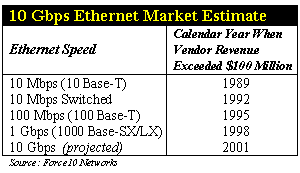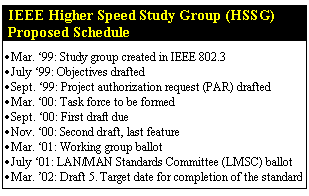NGN 99: 10 Gbps Ethernet is on the Way
By: John Spofford, Managing Editor, Premises Networks Online
Just when the standards had settled and it appeared safe to shop for Gigabit Ethernet equipment, it is time to move the decimal point. Standards activity already have begun on a new of Ethernet able to transport 10 Gbps. By next years' Networld+Interop Spring show, early proprietary demonstrations should be plentiful. At least one equipment vendor predicts a $100 million dollar market by 2001, and the 10 Gigabit standard is scheduled for completion by early 2002.
A newer, faster, better Ethernet should come as no great surprise, a tenfold increase of bandwidth is introduced every three years or so. (see chart, below)
"10 Gbps Ethernet is just another expansion of the popular Ethernet digital hierarchy," said Som Sikdar, chief technology officer of Santa Clara, CA-based Force10 Networks (formerly nCore Networks). "The intent of the work at [Institute of Electrical and Electronics Engineers] IEEE 802.3 is to retain the 802.3 frame format and packet sizes, drop the half-duplex mode of operation to simplify things a bit, and increase the link speed 10 times—just like the last three times."
Sikdar made his comments at the Next Generation Networks Conference (November 1–5, 1999, Washington, D.C.

With the development of 10 Gbps Ethernet, the Ethernet digital hierarchy will include two versions deployed mainly on copper (10 Mbps and 100 Mbps) and two optical versions (1 Gbps and 10 Gbps). The IEEE is reviewing proposals for both short-haul (300 m) and long-haul (20 km) optics, equivalent to Gigabit Ethernet 1000 Base-SX and -LX.
The short-haul 10 Gbps Ethernet is intended for in-building and equipment interconnect using multimode fiber. "Initially 10 Gbps will serve the traditional ‘fat pipe' role for the enterprise to aggregate Gigabit Ethernet traffic. In enterprise applications, 10 Gbps Ethernet will relieve congestion in the traditional hot spot—the core router," Sikdar said.
LAN Extension
The longer-haul version is intended for campus- and metro-area interconnects. "Coupled with long-reach optics, 10 Gbps Ethernet is a natural cross-campus interconnect candidate. For this role, single-mode fiber can be used up to a distance of 20 km," added Sikdar.
"The [wide-area network] WAN applications, we are talking about are relatively short links, a point that tends to be confused," said Bruce Tolley, manager of business development at 3Com (Santa Clara, CA). Tolley also is vice chairman, events for the Gigabit Ethernet Alliance and represents 3Com for IEEE802.3 and the Higher Speed (10 Gbps) Study Group. He sees longer-link applications to be mostly building-to-building links in metropolitan-area networks (MANs). Other uses for 10 Gbps Ethernet will be server interconnect for clusters of servers, and switch-to-switch connects such as connecting giga-routers inside Internet service provider POPs.
Unifying the LAN and WAN
"A WAN-compatible 10 Gbps Ethernet can serve both LAN and WAN communities without compromising either," said Paul Bottorff, director Switching Architecture Enterprise Solutions, Nortel Networks (Brampton, ON). "[With] LAN, MAN, and WAN data rates converging at 10 Gbps, it's a magic time to unify the local-, metro-, and wide-area networks—and 10 Gbps Ethernet is a logical candidate."
Calling the work on a 10 Gbps standard as a new application space for Ethernet, Bottorff proposes a new type of Ethernet tailored for the WAN, making it a "DS-1 of the next millenium. We've never had a point where carrier SONET data rates and Ethernet data rates closely matched," he said.
Short-haul 10 Gbps Ethernet potentially will provide an inexpensive interconnect between terabit routers and dense-wave division multiplexed (DWDM) networks. While 1 Gbps Ethernet has been a poor match to feed OC-48 (2.5 Gbps) SONET DWDM systems, the introduction of 10 Gbps Ethernet will be a more natural fit for emerging OC-192 systems.
Part of the early discussions is the creation of an Ethernet PHY that operates at 9.5846 Gbps, a data rate slightly less than 10 Gbps, but on that matches OC-192. This will allow Ethernet can be hauled over existing infrastructure, said Bottorff.
The advantages of Ethernet in the WAN is that of enhanced interconnectivity, he explained. Ethernet adds Layer 2 capability to an optical foundation and also can ensure compatibility between endpoints. Finally, the IEEE specifies multivendor interoperable interfaces for the WAN.
Cost also is a factor. While estimates for this yet undefined and undeveloped technology vary tremendously, Tolley estimated the costs for short-haul 10 Gbps to be perhaps 10 times that of Gigabit Ethernet. With the list price for Gigabit Ethernet at approximately $1,200 (and dropping rapidly) this price certainly would compare favorably with an OC-192 at $50,000 to $100,000 per interface.
Approaching a standard
IEEE Higher Speed Study Group (HSSG), created earlier this year, drafted a project authorization request in September. As the proposed schedule stands today, the 10 Gbps Ethernet standard will be completed in March 2002. (see chart, below)

While many observers feel the standards process will move quicker than Gigabit Ethernet, Tolley cautions that the schedule is "very aggressive. If it were to slip six months or more, [the standards activities] would still be considered successful."
Although the standards effort is only just begun, calendar year 2000 will undoubtedly bring demonstrations of proprietary solutions, and proof of concept demos of various options long before IEEE 802.3 is drafted. In the meantime, Tolley said, customers should be identifying whether there are compelling business reasons for the new technology. For those with truly bleeding edge applications, the opportunity to test drive the early proprietary products is a just few short months away.
For more information on the IEEE 803.3z specification: http://grouper.ieee.org/groups/802/3/10G_study/public/index.html
The Next Generation Networks Conference (November 1–5, 1999, Washington, D.C.), is an annual event in broadband networking that provides a forum to debate, discuss, and learn about emerging technologies and business applications for high-speed networking.
